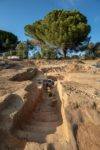 Archaeologists from France’s National Institute for Preventive Archaeological Research (INRAP) have discovered a high-ranking Etruscan grave in Aleria, Corsica. Dating to the 4th century B.C., the grave was dug out of the rock in a hypogeum (an underground chamber), a type of burial exclusively reserved for the elite of Etruscan society.
Archaeologists from France’s National Institute for Preventive Archaeological Research (INRAP) have discovered a high-ranking Etruscan grave in Aleria, Corsica. Dating to the 4th century B.C., the grave was dug out of the rock in a hypogeum (an underground chamber), a type of burial exclusively reserved for the elite of Etruscan society.
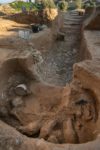 The entrance to the tomb is accessed by a corridor 20 feet long. A flight of steps lead to the corridor. Excavators found the tomb chamber six and a half feet under the surface still intact and sealed by a thick layer of clay, pebbles, coal and potsherds. It appears the seal was opened and closed several times, likely to make fresh offerings or inter the newly deceased.
The entrance to the tomb is accessed by a corridor 20 feet long. A flight of steps lead to the corridor. Excavators found the tomb chamber six and a half feet under the surface still intact and sealed by a thick layer of clay, pebbles, coal and potsherds. It appears the seal was opened and closed several times, likely to make fresh offerings or inter the newly deceased.
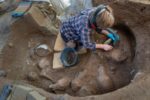 The ceiling of the tomb had collapsed and the interior was filled with earth so archaeologists had to dig from the top down. The excavation revealed a rectangular chamber 11 square feet in area containing pottery, bronze objects and a mirror. Three black-lacquered drinking vessels and two skyphoi (a wide two-handled cup) were found near a skull. This is as far down as archaeologists have gotten, even with the lowest step of the staircase. Any other human remains and grave goods are still pinned down under the collapsed material. Forensic specialists will aid in this final excavation phase.
The ceiling of the tomb had collapsed and the interior was filled with earth so archaeologists had to dig from the top down. The excavation revealed a rectangular chamber 11 square feet in area containing pottery, bronze objects and a mirror. Three black-lacquered drinking vessels and two skyphoi (a wide two-handled cup) were found near a skull. This is as far down as archaeologists have gotten, even with the lowest step of the staircase. Any other human remains and grave goods are still pinned down under the collapsed material. Forensic specialists will aid in this final excavation phase.
The discovery, announced this week, could yield new details on the existence of a stable Etruscan population in Corsica and help archaeologists understand the slow demise of the Etruscan civilization.
“It’s the missing link which will allow us to piece together Etruscan funerary rites, but it also reinforces the hypothesis that before the Roman conquest (in -259 B.C), Aleria was a transit point in the Tyrrhenian Sea, blending Etruscan, Carthaginian and Phocaean interests”, head curator Franck Leandri said.
The grave appears to belong to a high-ranking official, holding “about 15 ceramic vases similar to Etruscan pieces and what appears to be a mirror or the lid of a casing”, anthropologist Catherine Rigeade said at the site.
“We have some knowledge of Etruscan objects, but we know very little about Etruscan subjects; here we have both”, Rigeade added.
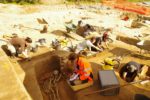 The tomb is part of a large necropolis with thousands of graves that was used in Etruscan and Roman times. Its existence was known and more than 100 graves were excavated by archaeologist Jean Jehasse in the 1960s, but the land is privately owned and slated for development which is why INRAP was given access in the first place. When the hypogeum tomb was discovered, its rarity and significance spurred authorities to order extended excavations. An example of a chamber tomb with a corridor entryway hasn’t been found in France for more than four decades.
The tomb is part of a large necropolis with thousands of graves that was used in Etruscan and Roman times. Its existence was known and more than 100 graves were excavated by archaeologist Jean Jehasse in the 1960s, but the land is privately owned and slated for development which is why INRAP was given access in the first place. When the hypogeum tomb was discovered, its rarity and significance spurred authorities to order extended excavations. An example of a chamber tomb with a corridor entryway hasn’t been found in France for more than four decades.
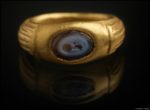 A number of different grave types have been unearthed in the dig ranging in date from the 3rd century B.C. to the 3rd century A.D. Archaeologists have found funeral pyres, pit burials, one with a tegula and imbrex (fired clay roof tiles) cover, masonry and wood formwork graves and more than 200 funerary offerings including 100 intact vases. Several stand-out pieces of jewelry were in the graves: a gold signet ring with a female face, a
A number of different grave types have been unearthed in the dig ranging in date from the 3rd century B.C. to the 3rd century A.D. Archaeologists have found funeral pyres, pit burials, one with a tegula and imbrex (fired clay roof tiles) cover, masonry and wood formwork graves and more than 200 funerary offerings including 100 intact vases. Several stand-out pieces of jewelry were in the graves: a gold signet ring with a female face, a 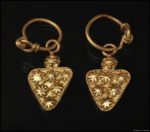 gold ring with an intarsio gemstone engraved with a seriously adorable tiny animal (possibly a squirrel) playing with a large ball discovered on the pubic bone of a burial dating to the 1st-3rd century A.D., and a pair of gold earrings festooned with stars found at the feet of an individual buried in a brick grave.
gold ring with an intarsio gemstone engraved with a seriously adorable tiny animal (possibly a squirrel) playing with a large ball discovered on the pubic bone of a burial dating to the 1st-3rd century A.D., and a pair of gold earrings festooned with stars found at the feet of an individual buried in a brick grave.
The skeletal remains that have been unearthed thus far are in unexpectedly good condition. Corsica’s highly acidic soil usually causes bones to disintegrate over time, but complete articulated skeletons have been discovered here.
Pirates of the Mediterranean –and later traders (i.e. wine from Italy for materials, maybe also gold, grain, ham etc. from Gaul) and -possibly- still pirating. However, according to Herodotus (Bk.I 165-167):
———-
“…Phocaians […] set out for Kyrnos [i.e. Corsica] for in Kyrnos, twenty years before this, they had established a city named Alalia [i.e. Aléria], in accordance with an oracle […] they first sailed to Phocaia and slaughtered the Persian garrison, to whose charge Harpagos had delivered the city; then after they had achieved this they made solemn imprecations on any one of them who should be left behind from their voyage, and moreover they sank a mass of iron in the sea and swore that not until that mass should appear again on the surface would they return to Phocaia. [..] When these came to Kyrnos, for five years they dwelt together with those who had come thither before, and they founded temples there. Then, since they plundered the property of all their neighbours, the Tyrsenians [i.e. Etruscans] and Carthaginians made expedition against them […] As for the crews of the ships that were destroyed, the Carthaginians and Tyrsenians obtained much the greater number of them, and these they brought to land and killed by stoning…” :skull: [cf. ‘Battle of Alalia’, between 540 BC and 535 BC]
———-
Looking forward reports of further digging and possible DNA analysis. And a huge ghank you for bringing us all the news you do 😁
Examine the materials also: The grave of the Lady of Vix in northern Burgundy (Mont Lassois, ca 500 BC) contained the largest known metal vessel from Western classical antiquity, i.e. the really massive ‘Vix Krater’, being 1.63 m (5’4″) in height and –without wine– over 200kg (450lbs) and an assemblage of imported objects from the Greek world, all of them associated with the preparation of wine. The region today is a premier wine-growing region in France.